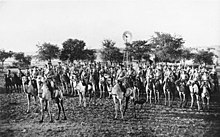Imperial Schutztruppe for German South West Africa
| Imperial Schutztruppe for German South west Africa | |
|---|---|
| Kaiserliche Schutztruppe für Deutsch-Südwestafrika | |
Mounted Infantry Artillery | |
| Part of | Schutztruppe |
| Engagements | Herero Wars South West Africa campaign |
The Imperial
Formation
Between October 1888 and July 1889, in the course of a dispute between the
Structure


The Schutztruppe in German Southwest Africa was structured in 12 companies of mounted infantry totalling ca. 2,000 men in July 1914, primarily Germans.
The colonial forces for German Southwest Africa consisted of volunteers from the imperial army and navy (including some Austrians), but essentially consisted of members of German regiments. Before their deployment to Africa these troops were prepared for their special tasks and future environment. Such a training base was at Karlsruhe. Because of the often humid conditions in the upper Rhine valley of the grand-duchy of Baden, the area provided some early acclimatization.
The structure of the Southwest African forces was as follows: German Southwest Africa Command at
Northern district command: Windhuk
- 1st Company: Regenstein, Seeis
- 4th Company: Okanjande
- 6th Company: Outjo and Otavi
- 2nd Battery: Johann-Albrechts-Höhe
- Transport platoon 1: Karibib
- Office for provisions: Karibib
- Horse depot: Okawayo
- Artillery and train depot: Windhuk
- Military hospital and medical depot: Windhuk
- Clothing depot: Windhuk
- Local headquarters: Windhuk
- Local headquarters and quartermaster: Swakopmund
Southern district command: Keetmanshoop
- 2nd Company: Ukamas
- 3rd Company: Kanus
- 5th Company: Chamis and Churutabis
- 7th and 8th Company (camel cavalry), military hospital: Gochas and Arahoab
- 1st Battery: Narubis
- 3rd Battery: Gibeon
- Transport platoon 2: Keetmanshoop
- Artillery and train depot: Keetmanshoop
- Military hospital and medical depot: Keetmanshoop
- Clothing depot: Keetmanshoop
- Office for provisions: Keetmanshoop
- Garrison administration: Keetmanshoop
- Horse depot: Aus
- Camel stud farm: Kalkfontein
- Local headquarters and quartermaster: Lüderitz
At the outbreak of World War I the force had a total strength of 91 officers, 22 physicians, 9 veterinarians, 59 civilian administrators, ammunition technicians, 342 NCOs and 1,444 German other ranks for a total of 1,967 personnel.[4]
References
- ^ Schildknecht, Jörg (2000). Bismarck, Südwestafrika und die Kongokonferenz: Die völkerrechtlichen Grundlagen der effektiven Okkupation und ihre Nebenpflichten am Beispiel des Erwerbs der ersten deutschen Kolonie [Bismarck, South West Africa and the Congo Conference: The international legal bases of the effective occupation and its secondary obligations using the example of the acquisition of the first German colony] (in German). LIT-Verlag.
- ^ Deutsches Kolonial-Lexikon [German Colonial Lexicon] (in German). Vol. III. 1920. p. 321.
- ^ ISBN 3-933117-51-8.
- ^ Haupt 1984, p. 56.
Bibliography
- ISBN 0-393-30564-3.
- Haupt, Werner (1984). Deutschlands Schutzgebiete in Übersee 1884–1918 [Germany’s Overseas Protectorates 1884-1918]] (in German). Friedberg: Podzun-Pallas Verlag. ISBN 3-7909-0204-7.

